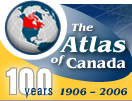| The growth rate between 1986 and 1996 for all services,
commercial (private) and public, ranged from 125% (Varennes, Quebec)
to -9.1% (Elliot Lake, Ontario).
Geographical Description
On this map, the circles indicate the population for 1996, while
the colours in the legend indicate the rates of growth, either positive
or negative. The rates suggest that growth was widely dispersed
across the country, with the exception of Saskatchewan and Manitoba.
The highest rates of growth occurred in British Columbia, Alberta
and in or near Toronto, Ottawa and Montréal. Of course, these
are some of the places with the highest per capita incomes. Cities
in the Atlantic provinces show some growth, but less than those
in Ontario and Quebec.
Most cities and rural areas close to Montréal showed very
low rates of growth. Halifax and Moncton, New Brunswick stand out
in the Atlantic provinces. Montréal and Québec contrast
with the smaller cities in Quebec. In general, the growth of service
employment was much slower in rural areas. In Ontario, growth was
higher for rural areas closer to Toronto. The high growth rates
around Toronto extend for 100 kilometres or more. Most population
centres around Vancouver and on Vancouver Island had similar high
growth rates.
To properly interpret this map, please consult the text Data
and Mapping Notes.
|
